Orwell Astronomical Society (Ipswich)
Comet C/2004 Q2 (Machholz), December 2004 - January 2005
Don Machholz, observing visually at the end of August 2004 with a 150 mm telescope, discovered the comet which was subsequently named after him and designated C/2004 Q4. Towards the end of December 2004, the object became visible in binoculars, and observers eagerly anticipated it becoming more prominent in mid-January as it climbed to a higher northern altitude and brightened. Predictions suggested that the comet would pass close to the Pleiades around 07-08 January at magnitude 3.0 - 3.5. Fortunately, weather conditions permitted observations from late December - mid January. Observing reports by members of OASI are below.
26 Dec 2004
Pete Richards
Bristol
The comet is now not too hard to find. I saw it with compact binoculars last night with a full moon in the sky.
28 Dec 2004
Gerry Pilling, Paddy O'Sullivan, Martin Cook
Orwell Park Observatory
Observed in binoculars and 250 mm Dobsonian. Easy to find in binoculars. We struggled with the Dobsonian for a while until we found the two guide stars! The comet appeared as a fuzzy blob with star-like centre.
30 Dec 2004
Mike Nicholls
Capel St Mary
Easily found and observed the comet at around 18:00 UT. Gerry Pilling's description (above) sums it up well. No sign of a tail: maybe it has formed pointing away from the Earth?
31 Dec 2004
Alan Smith
Grundisburgh
Observed the comet at around 20:00 UT with 10x50 binoculars and 250 mm reflector. Not the most spectacular object ever, but any new comet is always welcome! The best view is obtained with binoculars, where a broad, diffuse fan is pointing towards Orion (i.e. fanned to the left in binoculars). Could not discern any detail in the reflector.
12 Jan 2005
James Appleton
Orwell Park Observatory
Easily seen by naked eye approximately 10° N of the Pleiades. In 250 mm Dobsonian shows extensive haze surrounding bright nucleus, with some evidence of a tail (needs averted vision).
Images
- Mike Harlow, 02 Jan 2005. Image taken with a 17 mm lens and Starlight Express CCD. The image includes the end of the telescope and an aircraft trail! The comet makes an equilateral triangle with Aldebaran and the Pleiades. Obviously the imaging system needs some work on focus and tracking and I hope to get some better images over the next few months.
- As #1, but using a 55 mm lens. Extreme contrast stretching shows the two tails of the comet apparently pointing in opposite directions. In fact both are pointing away from Earth at a slight angle to each other.
- Dave McCracken, 02 Jan 2005. The diameter of the comet appeared to be approximately the same as that of the Moon. Position 03h 37m, +12° 45'. Photographed the comet with traditional 35 mm 200 ASA colour print film. Camera body fitted with a 200 mm zoom lens at f5.6, piggy-backed on the top of a Celestron C8 telescope for guiding; I tried to correct for any drift to within the "bulls eye" of the graticule (approx 10 arcsec). Exposure time 6 minutes. Commercial prints of the negatives were not good. The image shown below is scanned directly from the negative, at maximum resolution.
- Mike Harlow, 08 Jan 2005. The wind dropped and the sky cleared on Saturday 08 January as comet Machholz drifted past the Pleiades. The image below was taken by a 55 mm lens and Starlight Xpress CCD at f/4 with a 5 minute exposure. I applied considerable contrast stretching to the original image to bring out he very faint gas and ion tails now almost at right angles. Note also the nebulosity in the Pleiades.
- As #4, but using a 135 mm lens at f/4 for 5 minutes. The limiting magnitude is 14.5.
- Dave McCracken, 08 Jan 2005. Image taken using Celestron Wide Angle 80 mm (WA80) refractor with Nikon body attached via T mount. Nikon and WA80 piggy-backed on top of Celestron C8 and guided by eye. Tesco brand 400 ASA film. Image below is scanned at 1200 DPI from the print. Exposure 6 minutes at 19:55 UT. I am not sure how genuine the apparent tail is. It may be an artefact of lights from below or something else? The red / green trail is an AWAC aircraft from Waddington.
- Mike Harlow, 12 Jan 2005, 19.30 UT. Another image of comet Machholz passing a famous object, this time the California Nebula in Perseus. Image captured by Starlight Xpress CCD with 55 mm lens at f/4 with a 5 minute exposure. Image contrast stretched and presented as a negative to make the very faint ion tail more obvious. Field size is about 6.5x9.0° so the tail is about 5° long (if you stand back and squint!) California nebula at top left.
- Telescope and camera used by Dave McCracken.
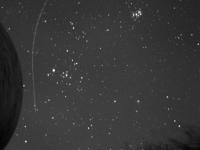 1. 02 Jan 2005, Mike Harlow.
1. 02 Jan 2005, Mike Harlow.
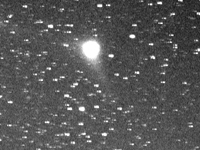 2. Contrast stretched, 02 Jan 2005, Mike Harlow.
2. Contrast stretched, 02 Jan 2005, Mike Harlow.
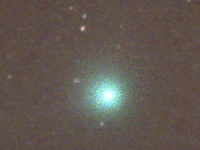 3. 02 Jan 2005, Dave McCracken.
3. 02 Jan 2005, Dave McCracken.
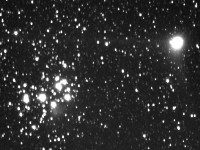 4. 08 Jan 2005, Mike Harlow.
4. 08 Jan 2005, Mike Harlow.
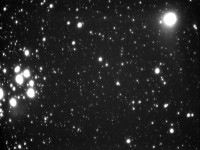 5. As previous image, but using 135 mm lens at f/4 for 5 minutes.
5. As previous image, but using 135 mm lens at f/4 for 5 minutes.
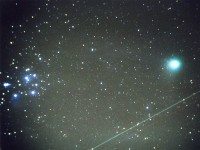 6. 08 Jan 2005, Dave McCracken.
6. 08 Jan 2005, Dave McCracken.
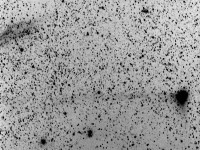 7. 12 Jan 2005, 19.30 UT, Mike Harlow.
7. 12 Jan 2005, 19.30 UT, Mike Harlow.
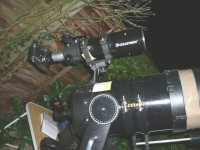 8. Telescope & camera, Dave McCracken.
8. Telescope & camera, Dave McCracken.
Compiled by James Appleton